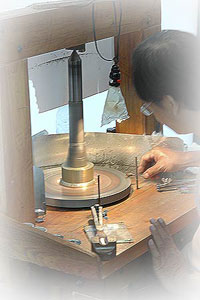
In the world of gem cutting, lapidary work is an art that involves shaping, cutting, and polishing gemstones to bring out their true beauty. It is a meticulous process that requires precision and skill.
When it comes to lapidary work, one of the key aspects is working with rough gems. Understanding how to handle and manipulate rough gems effectively is crucial for achieving desirable results. The quality and characteristics of rough gems play a significant role in determining the final outcome of the cut gemstone.
In order to work with rough gems, lapidary tools and equipment are essential. These tools range from saws and grinders to polishing wheels and laps. Each tool serves a specific purpose in the lapidary process, and understanding the different tools and their uses is pivotal for successful gem cutting.
Moreover, lapidary work involves different techniques that enable gem cutters to shape and polish gemstones precisely. These techniques include sawing, grinding, shaping, faceting, and polishing. Each technique requires a combination of skill, knowledge, and experience to master. By delving into the world of lapidary techniques, you will gain the expertise needed to transform rough gems into exquisite gemstones.
 Faceting gemstones is a skill that transforms rough gemstones into dazzling works of art. Whether you are a beginner or an experienced gem cutter looking to refine your skills, mastering faceting techniques is essential for creating beautiful facets that enhance the value and of gemstones. Faceting gemstones is a skill that transforms rough gemstones into dazzling works of art. Whether you are a beginner or an experienced gem cutter looking to refine your skills, mastering faceting techniques is essential for creating beautiful facets that enhance the value and of gemstones.
Brilliant Cut:
This technique maximizes the gemstone's brilliance by using a combination of triangular and kite-shaped facets.
Step Cut:
Ideal for gemstones with high clarity, the step cut features long, rectangular facets that create a distinctive, elegant appearance.
Portuguese Cut:
Known for its intricate pattern of facets, the Portuguese cut showcases the gemstone's color and play of light through a complex arrangement of facets.
Rose Cut:
This technique emphasizes the gemstone's surface and creates a flat base with a dome-shaped crown, resulting in a vintage, romantic look.
When selecting gemstones for faceting, it is important to consider various factors to achieve the best results. These factors include the gemstone's hardness, clarity, color, and shape. Gemstones with excellent clarity and color are often chosen for faceting as they can maximize the beauty and visual impact of the final product.
Faceting gemstones requires precision and attention to detail. It involves cutting and polishing a series of facets on the gemstone's surface to achieve the desired shape and enhance its natural beauty. Each facet must be carefully aligned and positioned to optimize light reflection and refraction, ultimately bringing out the gemstone's brilliance and sparkle.
It is not easy to say how long it takes to shape and facet a stone from beginning to end. Our experienced cutters, with many years of experience in all stages of gemstone cutting can finish approximately six stones per day. Some older cutters are experienced in all steps of gem faceting, while others are skilled only in certain steps. |
